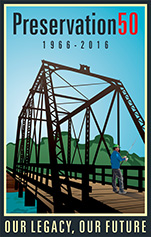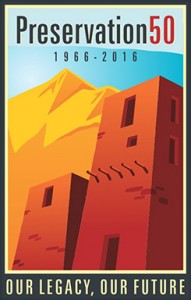
Anniversaries are big news. Last year was the 30th anniversary of the National Heritage Areas. This year in 2015 US ICOMOS reached the magical five decades. The Land and Water Conservation Fund will turn 40 in 2016. The much talked about Centennial of the National Park Service is also just over the horizon.
But it is the fiftieth anniversary of the National Historic Preservation Act of 1966 that has caught my attention and that of the historic preservation world. Passing the fifty year mark has special significance in a field that sets that number as the marker for determining a resource’s historicity. “Generally, properties eligible for listing in the National Register are at least 50 years old. Properties less than 50 years of age must be exceptionally important to be considered eligible for listing.
The rich irony of the National Historic Preservation program turning fifty and itself becoming historic has not been lost on many observers. So as the count down begins – with events that strike both a celebratory and a more reflective tone. A web site Preservation 50 has been launched as gathering point for information with well-designed posters and other merchandise. Trust the National Trust for Historic Preservation to find a position at the more festive end of the spectrum. The venerable Annual conference titled Past Forward (November 3-6 2015 in Washington DC) is “to begin a year-long celebration of the National Historic Preservation Act’s 50th anniversary with programming that celebrates and honors the past while looking decisively forward toward our next 50 years.”

The National Association of Preservation Commissions has adopted a slogan for their conference with the forced gaiety that usually marks an “over-the-hill” themed birthday party – Hip, Happening Historic Preservation @ 50. However, on a more serious note the organization is also calling for papers on future facing topics: Preservation@50, advocacy, diverse and underrepresented resources, and climate change
Goucher’s Historic Preservation Program is striking a more thoughtful tone with a national forum “A Critical Examination of the next Fifty Years”. The forum will examine predicted changes in America’s population, economy, natural environment, everyday technology, and education at all levels over the next 50 years will affect the theories, policies, and professional practice of historic preservation in the United States at all levels of government and within the private and non-profit sectors. Finally, taking the long view the The Public Historian and History@work teamed up in 2013 to inaugurate a set of conversations over the next three years “to assess the history, impact, and legacy of the National Historic Preservation Act of 1966.” – See the results here.
I for one am looking forward to these discussions. As in many fields that started as a movement, there gets to be a point where it is time to grow up. Historic Preservation is not alone in this problem; many of my colleagues in the environmental movement are facing the same challenge.
Some of the best ideas I have heard came from a recent talk by Randy Mason, Chair of the Graduate Program in Historic Preservation Program at the University of Pennsylvania. He urged practioners to redesign historic preservation. Perhaps even reframing our work not as preservation, but as conservation, design and planning. As a field we should be less dependent on prescriptive polices and not settle for small victories, but take more flexible and expansive approach.
This is music to ears of someone who has been urging a landscape scale vision for historic preservation, conservation and the future of sustainable communities. I look forward to more!


